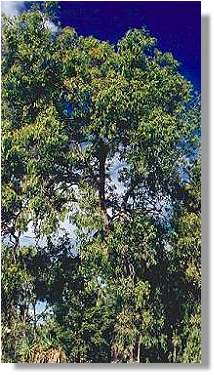Name
The Bloodwoods come from the subgenus Corymbia, genus Eucalyptus
and from the family Myrtaceae. The name ‘Bloodwood’
is derived from the trees kino (gum) veins, which are often seen oozing
red kino from lesions in the bark.
 Corymbia Clarksoniana
Woodland
Corymbia Clarksoniana
Woodland
Click to enlarge |
Location
The bloodwoods are widely distributed through a range of environmental
conditions, with a common occurrence in Northern Australia’s dry
tropics, of which Magnetic Island is situated.
Characteristics
The Bloodwoods may be divided roughly into two groups. The first are
the paper-fruited bloodwoods, of which there are approximately 8 species
of, ranging from small to large trees up to 35m tall. The second group
are the woody-fruited bloodwoods which comprise of approximately 35
species and are mainly small trees with the exception of some growing
to 30m. The fruits of the two groups may appear to be somewhat similar
in shape, however are easily distinguished by the thickness of the mature
fruits wall – hence the names, paper-fruits and woody-fruits!
Although a division occurs among the bloodwoods fruit, many species
often have a common distinctly tessellated bark. The outer, dead bark
is not deciduous like the smooth-barked gums, cracking into rough square
or rectangular pieces producing a scaly appearance.